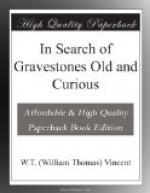Fig. 49.—At Bunhill fields, London.
“To Elizabeth Sharp, who died
Oct. 20, 1752,
aged 31 years.”
It is easy to read in this illustration the parable of death destroying a fruitful vine, and as a picture it is not inelegant. It is more remarkable as being, so far as I can find, the one solitary instance of an allegorical gravestone among the thousands of gravestones in the vast and carefully guarded burial-place in the City Road. Strictly speaking, death’s heads and crossbones are allegorical, but these must be excepted for their very abundance and their lack of novelty. Possibly, also, the lichen, damp, and London climate, which have obliterated many of the inscriptions in this old cemetery, may have been fatal to the low relief which is requisite for figure work of the kind under consideration. But Bunhill Fields and similar places in and near London and other great towns have taught me the law to which I have already referred—the law that the picture-tombstone was country bred, and could never have endured under the modern conditions of life in or near the centres of civilization.
There are exceptions, perhaps many, to this ruling, as there are exceptions to every other. For instance, a stone at the grave of a Royal Artillery Officer in Woolwich Churchyard combines the emblems of his earthly calling with those of his celestial aspirations in a medley arrangement not unusual in rural scenes, but hardly to be reconciled with the education and refinement of a large garrison and school of military science which Woolwich was in 1760. This must be set down as one of the exceptions which prove the rule.
Fig. 50.—At Woolwich.
“To Lieut. Thomas Sanders,
late of the Royal
Regiment of Artillery,
who died March
1760, aged 60
(?) years.”
There is a more recent case in which the same idea is pourtrayed in somewhat different fashion on a headstone in the obsolete graveyard of St. Oswald, near the Barracks at York. It is dedicated to John Kay, a private in the Royal Scots Greys, who died July 9, 1833, aged 34 years.
But, on the whole, it may be accepted as an axiom that originality has shunned the town churchyards, and the absence of curious varieties of the gravestone among the well-sown acres of Bunhill Fields and such-like places of the period at which they were by comparison so abundant in less considered localities admits of a simple explanation.
In the eighteenth century town and country were much more divided than they are now. London and the rural districts were not on their present level. Taste in art and in the ordinary affairs of life was being cultivated in town; it was not even encouraged in the country. Education and refinement were not thought to be desirable accomplishments in a rustic population, but dwellers in cities had been for generations improving their manners, and thus it was that no such provincial vulgarity as a decorated tombstone could be tolerated in the choice metropolis.




